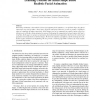1380 search results - page 58 / 276 » Learning Hierarchical Shape Models from Examples |
CVPR
2009
IEEE
15 years 2 months ago
2009
IEEE
A Bayesian marked point process (MPP) model is developed
to detect and count people in crowded scenes. The
model couples a spatial stochastic process governing number
and placem...
SIGGRAPH
2003
ACM
14 years 1 months ago
2003
ACM
Blend shape animation is the method of choice for keyframe facial animation: a set of blend shapes (key facial expressions) are used to define a linear space of facial expression...
ICML
2007
IEEE
14 years 8 months ago
2007
IEEE
This paper introduces a new approach to actionvalue function approximation by learning basis functions from a spectral decomposition of the state-action manifold. This paper exten...
NIPS
2003
13 years 9 months ago
2003
We address the problem of learning topic hierarchies from data. The model selection problem in this domain is daunting—which of the large collection of possible trees to use? We...
ICPR
2006
IEEE
14 years 8 months ago
2006
IEEE
Correspondence algorithms typically struggle with shapes that display part-based variation. We present a probabilistic approach that matches shapes using independent part transfor...


